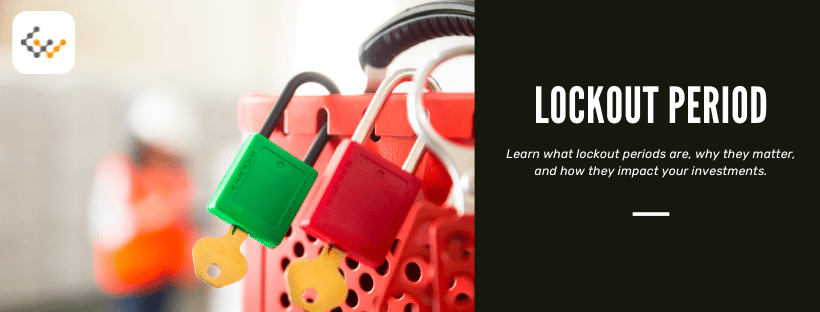Understanding Lockout Period in Commercial Real Estate

A lockout period is a specific, predetermined amount of time after the loan’s origination in which the loan cannot be prepaid. Lockout periods, when present, are defined within the loan contract and can be a negotiable condition in some situations. Since these periods can vary significantly from one organization to the next, investors should pay close attention to their presence and what they may mean for their specific financial needs.
Lockout Period and its Role in Commercial Real Estate Financing
A lockout period on a commercial real estate loan is a specific restriction that prevents the loan holder, or commercial property investor, from prepayment of the loan. A lockout imposes a penalty in situations where the investor pays off the loan during that period. Borrowers must consider, at that point, whether paying the penalty is worth refinancing or paying off the loan.
In commercial real estate financing, lockout periods can be an important factor for lenders. In situations where the borrower pays off the loan early, that means the lender does not earn the anticipated yield from that loan, impacting their financial rewards of lending. The lockout period, often expressed as a set number of years from the origination date, is often overlooked when comparing commercial real estate loans. It is not a fee paid initially at the closing but only when the loan is paid off in full early.
As a result, some investors may not pay much attention to this feature when comparing loan terms. Yet, some of today’s commercial mortgage lenders have put in place long-term lockout periods, some of which range from 5 years or more. That can create a significant limitation on refinancing the loan.
From the perspective of a commercial lender, this period helps protect their continued ability to lend. From the investor’s point of view, lockout periods can be restrictive.
Lockout periods are legal obligations. They prevent the sale or refinancing of the property within that period without a hefty penalty. As a result of that, all borrowers must pay close attention to these terms. Failure to pay the penalty could result in legal action against the borrower.
Why Lenders Use Lockout Periods
The fast-changing world of commercial real estate financing has spurred an increase in lockout rates. Specifically, high-interest rates and inflation have made it much more expensive for some borrowers to secure lower-priced loans. This also makes it more challenging for lenders to close on loans.
However, there is significant anticipation that interest rates will be lower in the next few years. That’s led to an opportunity for commercial investors to turn to available financial loans that may be more expensive now with the expectation of refinancing them later when rates fall. Lockout periods help to minimize this risk to lenders or control it more effectively.
Typical Lockout Period Durations
Typical lockout periods may be 1 to 3 years, though some are in place for just six months (or some loans do not have a lockout period at all). These periods can be longer, too, extending five years or, in some rare situations, for the entire length of the loan.
There is no standard. That means that this is one of the factors investors must consider carefully before making the decision to utilize that loan.
Different types of lockout periods exist
Keep in mind that not all lenders use lockout periods. Some also offer various strategies that place limitations on these loans in far less restrictive methods.
For example, some lenders will put in place a step-down lockout. That means that, during the lockout period, the penalty for prepayment lessens over time. This could make it slightly less burdensome for the lender.
Implications of Lockout Period for Borrowers
The most significant implication for lockout periods in commercial real estate loans is the limitation it places on the borrower. With such a limitation in place, the borrower cannot sell the property or refinance the loan during that lockout period.
If a buyer for the property approaches the borrower with a sizable opportunity, the borrower must take into consideration the penalty and how that could impact the investment itself. In many situations, the borrower is locked into the loan for the long term. If a borrower finds themselves struggling with a specific financial situation, such as market conditions changing or the property is no longer lucrative, the lockout period limits the investor’s ability to make substantial changes or get out from under the loan.
Also notable is that if interest rates drop significantly, a lockout period does not allow investors to take advantage of those lower rates, which could save hundreds of thousands of dollars if a lockout period is in place. There is no upside to lockout periods in commercial real estate for the borrower.
In fact, the lockout period will limit the borrower. It offers the lender the benefit of taking advantage of higher interest rates that may be in place now and minimizes their losses if the market conditions change.
Alternative Loan Options with Shorter or No Lockout Periods
Borrowers may be able to negotiate better terms with the lender they wish to work with that do not include lockout terms. The best strategy to do this is to consider the current market value and the potential for interest rates to drop. Lenders may be willing to be more flexible with a well-qualified borrower. Other times, they may have policies in place that severely limit the ability to negotiate the lockout period out of the loan term.
In these situations, it may be best to look for alternative loan options that do not have lockout periods or offer shorter periods. Investors should take into consideration all commercial loans they qualify for and then determine which lender has placed lockout periods and avoid those. In short, most types of commercial investment loans may have lockout periods, while some lenders do not charge them. Compare loan terms carefully before making the decision to invest in any single given opportunity.
For example, instead of a traditional commercial loan, borrowers may wish to explore bridge loans. These are designed for short-term use, and they tend to have any type of prepayment penalty. Instead, the loan is in place for a shorter period of time, when the loan is then paid off in full or refinanced. Though some bridge loans still contain lockout periods, many are much shorter than what is found in traditional lockout loans. The difference could be months compared to years. Note that some lenders do not place lockout periods at all. In most situations, borrowers will want to seek out and qualify for these loans, especially in volatile market conditions.
Wrapping Up
Lockout periods are one of the potential terms present in today’s commercial real estate loans. Though not always present, when they are, it can make it very costly for an investor to refinance their loan or sell the property due to this restriction. As an investor, carefully consider any loan with such a limitation and restriction before making the decision to invest in that particular lender. It may be wise to look for alternative options without these restrictions.

